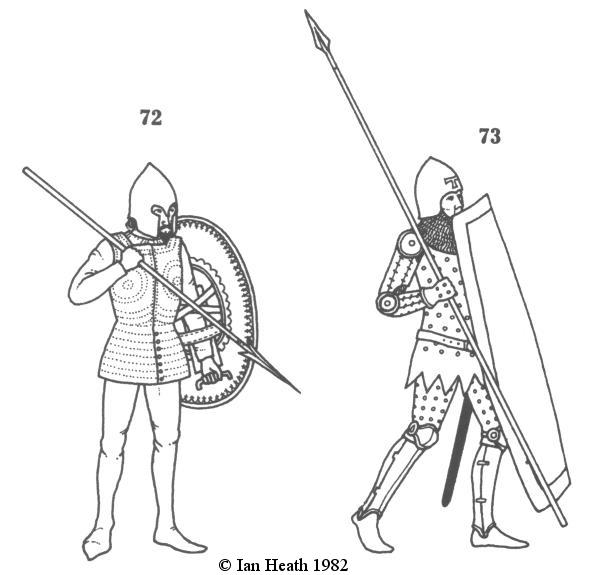|
|
ITALIAN INFANTRYMEN, 14th CENTURY
An extract from Armies of the Middle Ages, volume 1
by Ian Heath

[72 based on Scenes from the Life of St. James, by Altichiero da Zevio, 1376-79 - The Battle of Clavigo]
[73 based on the Victory of the Sienese Troops at Val di Chiana in 1363 by Lippo Vanni also known as The Battle of Sinalunga]
72 & 73. ITALIAN INFANTRYMEN, 14th CENTURY
Judging from 14th century lists of equipment Italian infantry were provided with panciera (mail corselet), helmet, gauntlets, sword, knife, and lance, bow or crossbow, archers and crossbowmen not usually having the knife or gauntlets.
Most pictorial sources, however, indicate that the principal form of body-armour in use among Italian infantry was the brigandine, as witnessed by these 2 figures from Padua (c.1370) and Siena (1373) respectively.
Figure 73 is actually from a fresco depicting the Battle of Sinalunga in 1363,
a Sienese victory over the mercenary Compagnia del Capello of Niccolò da Montefeltro, in which he and others like him are shown marching alongside and in front of the crossbow companies,
therefore probably indicating that he is one of the 'shield-bearers' frequently referred to in Italian sources (comparable to the French pavésier).
In this fresco they, their officers (who are mounted) and the crossbowmen all appear to have a white tau cross device painted on the fronts of their helmets.
The arm harness and gauntlets are of leather, with iron besagews at shoulder and elbow.
Both carry large shields, which appear to have been characteristically Italian.
The large oval type of 72 was in common use after the mid-14th century, as were tall, near-rectangular pavises like that of 73.
Kite-shields also continue to appear in Italian pictures until the late-15th century.
The helmet worn by 72 is an early barbuta (in French a barbute).
This term first appears in Italy in the mid-14th century, though it is not clear at that date what was intended by it.
By 1430 the term certainly applied to a type of sallet with usually only a narrow face opening, which was often T-shaped or akin to ancient Corinthian types (see 79a).
The barbute was sometimes called a 'Venetian sallet'.
Barbutes, bascinets and simple skull-caps were the usual helmets worn by Italian infantry, the kettle-helmet being uncommon.
Next: 74. ITALIAN LIGHT INFANTRYMAN, 14th CENTURY in Armies of the Middle Ages, Volume 1 by Ian Heath
|

